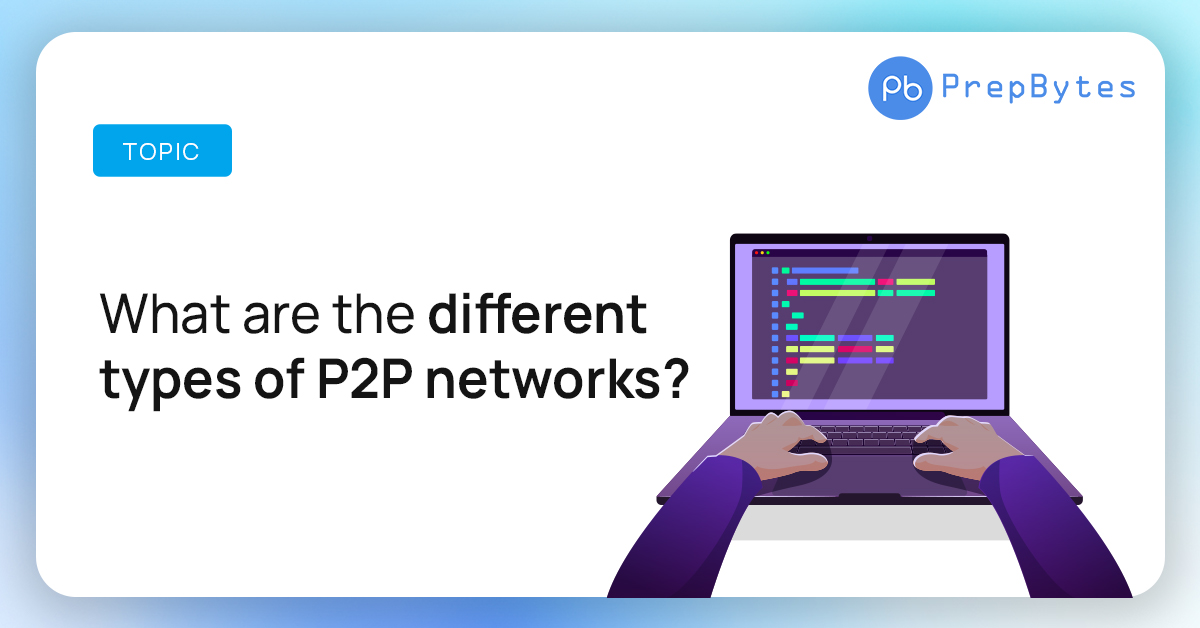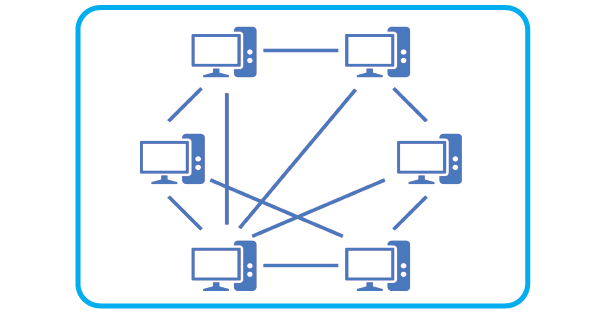Last Updated on January 30, 2024 by Ankit Kochar

Peer-to-Peer (P2P) networks have become a fundamental architecture for decentralized communication and resource sharing. In these networks, each node, or peer, acts both as a client and a server, contributing to the collective functionality of the network. Understanding the various types of P2P networks is crucial for comprehending their diverse applications and architectures. This article aims to explore the different types of P2P networks, shedding light on their characteristics, advantages, and use cases.
What are P2P Networks?
A Peer-to-Peer (P2P) network is a decentralized network architecture in which individual devices, called "peers," interact and collaborate directly with each other to share resources, information, or services without the need for a central server. Unlike traditional client-server models where a central server mediates communication and resource distribution, P2P networks distribute the roles and responsibilities across participating devices.

In a P2P network, each device can act both as a consumer and provider of resources. This decentralized nature offers several advantages, including increased scalability, fault tolerance, and reduced dependency on a single point of failure. P2P networks have played a pivotal role in various applications, ranging from file sharing and content distribution to distributed computing and blockchain technology.
There are different types of P2P networks, including unstructured, structured, and hybrid networks, each with its own organization and communication mechanisms. Unstructured networks allow peers to connect without a specific layout, while structured networks follow a defined structure, often using distributed hash tables (DHTs) for efficient data retrieval. Hybrid networks combine elements of both approaches to balance ease of use and efficient data location.
Let’s discuss different types of P2P networks.
Types of P2P Networks
There are three different types of P2P networks.
- Unstructured P2P networks
- Structured P2P networks
- Hybrid P2P networks
Unstructured P2P networks
Within unstructured peer-to-peer (P2P) networks, nodes lack a specific arrangement, resulting in random node-to-node communication. This makes unstructured P2P networks particularly suitable for applications with high activity levels, such as social platforms, where users frequently enter or exit the network.
However, unstructured P2P networks come with a drawback. They demand a substantial amount of CPU and memory resources to operate effectively. Hardware must support the maximum network transactions to ensure seamless communication among all nodes. This can pose a challenge, especially for large networks or those experiencing high activity volumes.
Structured P2P networks
Structured peer-to-peer (P2P) networks differ from unstructured ones, offering organized interaction among nodes. Achieved through a well-defined architecture, these networks enable users to locate and utilize files more efficiently, eliminating random searches. Hash functions often facilitate database lookups in structured P2P networks.
While generally more efficient, structured P2P networks exhibit some degree of centralization due to their organized setup. This can result in higher maintenance and setup costs compared to unstructured P2P networks. Nevertheless, structured P2P networks provide greater stability than their unstructured counterparts.
Hybrid P2P networks
Hybrid peer-to-peer (P2P) networks combine P2P architecture with the client-server model. This hybridization introduces a central server with P2P capabilities, proving advantageous for specific network scenarios.
Hybrid P2P networks offer numerous advantages over structured and unstructured networks, including strategic approaches, enhanced performance, and other benefits. Overall, hybrid P2P networks present a compelling choice for networks that seek to leverage both P2P and client-server architectures.
Advantages of P2P Networks:
– Decentralization:** P2P networks eliminate the need for a central server, distributing the workload and enabling direct communication between peers. This reduces the risk of a single point of failure and enhances fault tolerance.
-
Scalability: P2P networks can easily scale by adding more peers to the network. As more nodes join, the network’s capacity and resources grow organically.
-
Resource Sharing: P2P networks facilitate efficient sharing of resources such as files, data, and computing power. This enables collaborative efforts and reduces the need for redundant storage.
-
Cost Efficiency: P2P networks can operate with lower infrastructure costs compared to traditional client-server models, as the burden of maintaining and managing a central server is reduced.
-
Self-Healing: Due to their decentralized nature, P2P networks can recover from failures more gracefully. If a node goes offline, other nodes can compensate by taking over its tasks.
Disadvantages of P2P Networks
-
Security Concerns: The open nature of P2P networks can expose them to security risks, including unauthorized access, data breaches, and malware distribution.
-
Quality and Reliability: The quality and reliability of resources shared on P2P networks can vary significantly, making it important to verify the legitimacy and integrity of files.
-
Management Complexity: Maintaining a P2P network can be more complex than a traditional network, requiring specialized protocols and mechanisms to ensure proper coordination.
-
Legal and Copyright Issues: P2P networks have been associated with copyright infringement due to the ease of sharing copyrighted material. This has led to legal challenges for both users and network operators.
-
Lack of Central Control: While decentralization is a strength, it can also lead to challenges in enforcing rules, policies, and governance across the network.
Applications of P2P Networks
-
File Sharing: P2P networks revolutionized file sharing by enabling users to share files directly without relying on a central server. Examples include BitTorrent for large file distribution.
-
Content Distribution: P2P networks are used for efficient content delivery, reducing the load on central servers. Video streaming platforms often utilize P2P for faster and more reliable streaming.
-
Distributed Computing: P2P networks can harness the combined computational power of connected devices for tasks like scientific research, rendering, and simulations.
-
Collaborative Tools: P2P networks facilitate collaboration in real-time by enabling users to share documents, resources, and communication channels.
-
Decentralized Finance (DeFi): P2P networks underpin many DeFi platforms, allowing users to engage in financial transactions without intermediaries.
-
IoT Networks: P2P architecture can be applied in Internet of Things (IoT) networks to enable devices to communicate directly with each other, reducing latency and improving efficiency.
-
Instant Messaging and Voice Calls: P2P technology supports peer-to-peer messaging and voice calls, allowing users to communicate directly without going through a central server.
Examples of Peer To Peer Networks
1. BitTorrent:
BitTorrent is a popular peer-to-peer file sharing protocol used to distribute large files efficiently. Users download and upload parts of the file simultaneously, reducing the strain on any single server. BitTorrent clients connect to a network of peers, sharing the portions of the file they have with others. This approach allows for faster and more reliable file distribution.
2. Skype:
Skype, a well-known communication platform, employs peer-to-peer technology for voice and video calls, as well as instant messaging. When users make calls or send messages, the data is sent directly between peers rather than going through a central server. This enhances call quality and reduces latency.
3. Bitcoin:
Bitcoin operates on a blockchain, which is a type of distributed and decentralized peer-to-peer network. Participants, known as nodes, validate and record transactions, ensuring the security and integrity of the cryptocurrency system. The decentralized nature of Bitcoin’s network prevents single points of control and enhances security.
4. Dropbox (Selective Sync):
Dropbox uses a peer-to-peer approach for its "Selective Sync" feature. When a user wants to sync files between devices, Dropbox may use other devices that already have the same files to transfer data directly. This reduces the need for all data to pass through Dropbox’s central servers.
5. RetroShare:
RetroShare is a private and secure communication platform that operates on a peer-to-peer network. It allows users to create encrypted connections with their friends, enabling private messaging, file sharing, and even forums within a secure network of peers.
6. Freenet:
Freenet is a peer-to-peer platform designed for the distribution of information in a censorship-resistant manner. Users can publish content on Freenet, and the data is distributed across the network’s nodes. The decentralized nature of Freenet ensures that content remains accessible even if specific nodes are offline or blocked.
7. eMule:
eMule is a P2P file-sharing application that uses a combination of the eDonkey network and the Kad network. Users can search for and download files from other users’ devices directly. It allows for the sharing of various types of files, including documents, audio, video, and software.
8. Tribler:
Tribler is a P2P client that focuses on privacy and anonymity. It integrates torrenting, video streaming, and a built-in search engine, all while ensuring user privacy by avoiding centralized servers.
9. Ares Galaxy:
Ares Galaxy is a P2P file-sharing software that connects users to share various types of files, including media files, software, documents, and more. It supports a wide range of formats and provides a platform for users to find and download content directly from peers.
10. IPFS (InterPlanetary File System):
IPFS is a distributed peer-to-peer hypermedia protocol designed to make the web faster, safer, and more open. It uses content-addressing and decentralized distribution to enhance data integrity and reduce reliance on centralized servers.
These examples showcase the versatility of peer-to-peer networks across various domains, including file sharing, communication, cryptocurrency, content distribution, and more.
Conclusion
In conclusion, the diverse types of Peer-to-Peer networks showcase the versatility of this decentralized architecture. From pure P2P to hybrid and overlay networks, each type serves specific purposes and applications, contributing to the efficiency and scalability of decentralized systems. As technology advances, the significance of P2P networks continues to grow, offering innovative solutions for file sharing, communication, and distributed computing.
FAQ (Frequently Asked Questions) for Peer To Peer Networks:
Here are some FAQs on different types of Peer To Peer Network.
1. What distinguishes pure P2P networks from other types?
Pure P2P networks operate without a central server, allowing each node to act as both a client and a server. This decentralized structure enhances resilience and scalability.
2. How do hybrid P2P networks combine characteristics of both centralized and decentralized systems?
Hybrid P2P networks incorporate elements of both centralized and decentralized architectures. They often have a central authority for certain functions while leveraging P2P principles for other tasks.
3. What is the role of overlay networks in P2P architecture?
Overlay networks create an additional layer over the physical network to facilitate communication between nodes. They help in organizing and optimizing P2P connections.
4. Can P2P networks be used for more than just file sharing?
Yes, P2P networks have diverse applications beyond file sharing, including communication platforms, content distribution, and collaborative computing.
5. How do unstructured P2P networks differ from structured ones?
Unstructured P2P networks lack a defined organization, making them flexible but potentially less efficient in resource discovery. Structured P2P networks have a well-defined organization for efficient data retrieval.
6. What challenges are associated with scalability in P2P networks?
Scalability challenges in P2P networks include managing an increasing number of nodes, ensuring efficient resource discovery, and minimizing the impact of churn (node join and departure).


